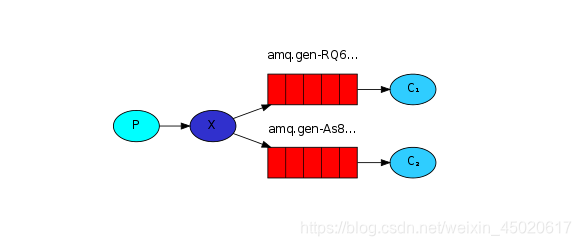
Fanout广播模型:
- 可以有多个消费者
- 每个消费者都有自己的队列(queue)
- 每个队列都要绑定到交换机(exchange)
- 生产者发送的消息,只能发送到交换机,交换机决定要发给哪个队列,生产者无法决定
- 交换机把消息发送给绑定过的所有队列
- 队列的消费者都能拿到消息,实现一条消息被多个消费者消费
代码实现:
1.创建生产者
import com.rabbitmq.client.Channel;
import com.rabbitmq.client.Connection;
import utils.RabbitMQUtils;
/**
* 生产者
*/
public class Provider {
public static void main(String[] args) throws Exception {
//获取连接对象
Connection connection = RabbitMQUtils.getConnection();
Channel channel = connection.createChannel();
//将通道声明指定的交换机
//参数1:交换机名称
//参数2:交换机类型 fanout 广播类型
channel.exchangeDeclare("logs","fanout");
//发布消息
channel.basicPublish("logs","",null,"fanout message".getBytes());
//释放资源
RabbitMQUtils.closeConnectionAndChanel(channel,connection);
}
}2.创建消费者1
import com.rabbitmq.client.*;
import utils.RabbitMQUtils;
import java.io.IOException;
/**
* 消费者1
*/
public class Customer1 {
public static void main(String[] args) throws Exception {
//获取连接对象
Connection connection = RabbitMQUtils.getConnection();
//获取通道对象
Channel channel = connection.createChannel();
//通道绑定交换机
channel.exchangeDeclare("logs","fanout");
//获取临时队列
String queue = channel.queueDeclare().getQueue();
//绑定交换机和队列
//参数1:队列名称
//参数2:交换机名称
//参数3:路由key 在fanout模型中用不上
channel.queueBind(queue,"logs","");
//消费消息
channel.basicConsume(queue,true,new DefaultConsumer(channel){
@Override
public void handleDelivery(String consumerTag, Envelope envelope, AMQP.BasicProperties properties, byte[] body) throws IOException {
System.out.println("消费者1:"+new String(body));
}
});
}
}3.创建消费者2
import com.rabbitmq.client.*;
import utils.RabbitMQUtils;
import java.io.IOException;
/**
* 消费者2
*/
public class Customer2 {
public static void main(String[] args) throws Exception {
//获取连接对象
Connection connection = RabbitMQUtils.getConnection();
//获取通道对象
Channel channel = connection.createChannel();
//通道绑定交换机
channel.exchangeDeclare("logs","fanout");
//获取临时队列
String queue = channel.queueDeclare().getQueue();
//绑定交换机和队列
//参数1:队列名称
//参数2:交换机名称
//参数3:路由key 在fanout模型中用不上
channel.queueBind(queue,"logs","");
//消费消息
channel.basicConsume(queue,true,new DefaultConsumer(channel){
@Override
public void handleDelivery(String consumerTag, Envelope envelope, AMQP.BasicProperties properties, byte[] body) throws IOException {
System.out.println("消费者2:"+new String(body));
}
});
}
}4.创建消费者3
import com.rabbitmq.client.*;
import utils.RabbitMQUtils;
import java.io.IOException;
/**
* 消费者3
*/
public class Customer3 {
public static void main(String[] args) throws Exception {
//获取连接对象
Connection connection = RabbitMQUtils.getConnection();
//获取通道对象
Channel channel = connection.createChannel();
//通道绑定交换机
channel.exchangeDeclare("logs","fanout");
//获取临时队列
String queue = channel.queueDeclare().getQueue();
//绑定交换机和队列
//参数1:队列名称
//参数2:交换机名称
//参数3:路由key 在fanout模型中用不上
channel.queueBind(queue,"logs","");
//消费消息
channel.basicConsume(queue,true,new DefaultConsumer(channel){
@Override
public void handleDelivery(String consumerTag, Envelope envelope, AMQP.BasicProperties properties, byte[] body) throws IOException {
System.out.println("消费者3:"+new String(body));
}
});
}
}5.分别启动3个消费者,再启动生产者

 ?
?
都消费到了消息。
更多:
RabbitMQ学习笔记一:了解及在Linux下安装RabbitMQ